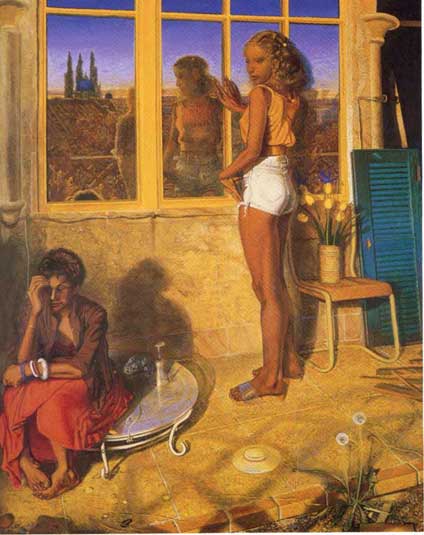The dark woman wears a Chinese hat, but she is not Chinese. This then is a tribute to the East, and this is indicated by her place on the right (Eastern) side of the composition. The Western woman (who is Mediterranean or Middle Eastern rather than Far-Eastern) as Eastern figure is endowed with occult knowledge, as is suggested by the attributed Vermeer, Girl with a Flute. The supplicant wears green shoes (life, vitality, youth) while the "knower" wears red shoes indicating the point of life meeting death in the spilling of blood as suggested by the Catholic concept of "Baptism of Blood." The gesture suggests the supplicant's approach to the threshold which itself may be death, or at least so-called ego-death. The gesture of supplication and its acknowledgement by the dark woman suggest the first contact of the two in a contractual narrative. Subsequent paintings show the narrative advance into the initiation and even the "coronation" (if even by way of death) of the supplicant.
 |
|
La Vista Totale:apv V, Between Amherst and Delphi, 104 x 68, 1993-95 |
Across the river in the valley below is a bridge- this bridging of water and of division (symbolized by the river) is about to be re-enacted by the two figures in the higher place above the valley. Their "contract" is a "bridge." The location for this painting is an expansion of elements from the Schuykill river valley; the location of the two figures is remote from the world below, though not from wilderness. After all, engineers have been there before to lay a drainage system, though this former presence has something of the quality of antiquity - of ruins being present in Poussin ("et in Arcadia Ego") or Salvator Rosa. Also, hunters have been there, as evidenced by the rabbit. This place then is known to hunters, as the wilderness was known to Artemis and the wood nymphs who congregated around her.
Thus also the cave as a dwelling for the dark woman. (Into the twelfth century, the devotees of Artemis/Diana worshipped in caves.) The dark woman lives in this semi-wild place, whereas the blonde woman (a pilgrim or seeker) has traveled here from below - from the sunny and fertile land below. She is pure of heart. This is also true of the model who posed for her, Lynn H., who in part, generated this "character" by way of her own character. Lynn was so unencumbered as a person, so apparently pure of heart, that she was commonly known among artists she posed for as "the Angel." The dark figure was generally based on Diane P. (Diana, Artemis, Cynthia) who foreshadows her iconic maturity into Kali at a later date ( I do a painting in 1995 called "Diana teaches Kali to Hunt" and include an encounter between these two in a manuscript for a short book "Shiva and Kali" which also appears in part within the larger Kali Rules. The pure supplicant (my female Percival) is kept safe from the dark woman by the channel of water, just as Von Helsing isolates vampires. Bram Stoker claims that the vampire may only cross a threshold when invited by the other. According to my painting, only the pure of heart may dare to invite the vampire (pagan goddess, Kali) and safely share the knowledge of this dark creature. This is an initiation, the beginning of a ritual confirmation of power (or knowledge, insight, what have you) between soon-to-be equals, The contract occurs parallel to the picture plane, the relation of figure to figure is parallel to the picture plane. The contract itself is where the relationship is, between the figures and above the stream of water that divides them. The viewer is in perpendicular relation to this plane, thus the viewer occupies another dimension that interacts with the contract, and this perpendicular relation to the picture plane originated in Joy of Life (1973) and is more encoded in narrative picture space in Mary and Martha (also called Bethany, c. 1978-81).
 |
|
Mary
and Martha, 102 x 81, 1979-82
|